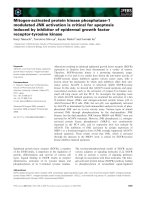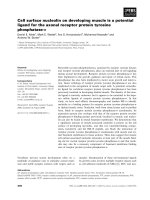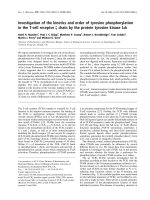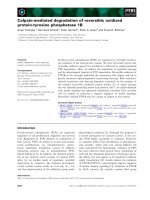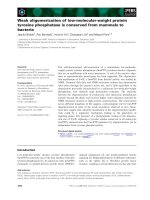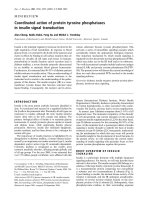Organometallic scaffolds as protein tyrosine phosphatase 1b inhibitor
Bạn đang xem bản rút gọn của tài liệu. Xem và tải ngay bản đầy đủ của tài liệu tại đây (2.44 MB, 84 trang )
ORGANOMETALLIC SCAFFOLDS AS PROTEIN TYROSINE
PHOSPHATASE 1B INHIBITOR
ONG JUN XIANG
(B.Sc.(Hons.), NUS
A THESIS SUBMITTED
FOR THE DEGREE OF MASTER OF SCIENCE
DEPARTMENT OF CHEMISTRY
NATIONAL UNIVERSITY OF SINGAPORE
2012
I
Declaration
Thesis Declaration
The work in this thesis is the original work of Ong Jun Xiang, performed independently under
the supervision of Dr Ang Wee Han, (in the laboratory S15-05-01), Chemistry Department,
National University of Singapore, between 1/8/2010 and 24/8/2012.
Ong Jun Xiang
Name
Signature
23/8/2012
Date
I
Acknowledgements
Acknowledgements
I would like to express my greatest gratitude to my supervisor Dr Ang Wee Han for his
guidance, valuable advice and patience throughout my course of research. I am really fortunate
to be his student as he taught me many things within and outside the realm of Chemistry. I would
also like to express my heartfelt thanks to Dr Yap Chun Wei for his input on molecular docking
studies.
My sincere thanks to the technical staff at X-ray diffraction (Prof. Koh, Ms Tan and Ms
Hong), Nuclear Magnetic Resonance (Mdm. Han), Mass spectrometry and Elemental Analysis
laboratories for their technical support.
I would like to thank my group members Chee Fei, Daniel, Mun juinn, Diego and Tian
Quan for their assistance and helpful discussions.
I am grateful to NUS for my research scholarship.
Lastly, I am very thankful to my family members and friends for their love and support.
II
Table of Contents
Table of Contents
Summary ....................................................................................................................................... V
List of Tables .............................................................................................................................. VII
List of Figures ........................................................................................................................... VIII
List of Schemes ............................................................................................................................ IX
List of Abbreviations ................................................................................................................... X
1. Introduction ............................................................................................................................... 1
1.1. Protein Tyrosine Phosphatase 1B as drug target ................................................................. 1
1.2. Organic inhibitors of Protein Tyrosine Phosphatases ......................................................... 4
1.3. Metal complexes as inhibitors of Protein Tyrosine Phosphatases ...................................... 6
2. Design concept of metallo-inhibitors ....................................................................................... 9
2.1. Design of Ruthenium-based inhibitor ................................................................................. 9
2.2. Design of Gold-based inhibitor ......................................................................................... 10
3. Synthesis of organoruthenium and organogold PTP inhibitors ......................................... 12
3.1. Synthesis of ligands ........................................................................................................... 12
3.2. Synthesis of organoruthenium inhibitors .......................................................................... 15
3.3. Synthesis of organogold inhibitors .................................................................................... 21
4. Biological evaluation of organoruthenium PTP inhibitors ................................................. 24
4.1. Aqueous stability of organoruthenium PTP inhibitors ...................................................... 24
III
Table of Contents
4.2. Inhibition of PTP-1B and TC-PTP by organoruthenium PTP inhibitors .......................... 25
4.3. Determination of inhibition constants of 4a towards PTP-1B and TC-PTP ..................... 30
5. Conclusion ............................................................................................................................... 32
6. Experimental Section .............................................................................................................. 33
6.1. Preparation of organoruthenium complexes...................................................................... 35
6.2. Preparation of organogold complexes ............................................................................... 44
Appendix ...................................................................................................................................... 50
References .................................................................................................................................... 67
IV
Summary
Summary
This thesis describes the synthesis and evaluation of two novel classes of organoruthenium
and organogold complexes as inhibitors of protein tyrosine phosphatases (PTPs). The findings of
the research are presented in four chapters.
Chapter 1 gives an introduction to protein tyrosine phosphatase 1B (PTP-1B) and its
potential as a therapeutic drug target. The major challenge in the attempt to design inhibitors of
PTPs arose from their highly conserved enzymatic active-site across the PTP family. Selectivity
against closely related PTPs could be low due to the structural homologies. This is particularly
problematic for PTP-1B since it is 80% homologous with T-cell protein tyrosine phosphatase
(TC-PTP) in their catalytic domains. So far, the organic and metallo-inhibitors synthesized to
date have yet to achieve high selectivity towards PTP-1B against TC-PTP.
Chapter 2 describes the concepts behind the design of the organoruthenium and
organogold complexes respectively. Since PTPs possess an active-site which is highly conserved
across the PTP family, targeting the active-site to achieve selectivity among the various PTPs
will not be a feasible approach. We reasoned that the proximal space to the PTP active-site must
be important for the molecular recognition of their protein substrate. By capitalizing on the
potential difference in the structural environment proximal to the active-site, we hope to develop
metallo-inhibitors that are selective towards specific PTPs. To do so, we would rationally build
molecules which can simultaneously bind to the active-site as well as being able to interact with
the chemical space proximal to the active-site of the PTPs.
Chapter 3 describes the synthesis of the ligands and their respective organoruthenium and
organogold complexes. The reaction of imidazole/benzimidazole difluoromethylphosphonate
esters, 1 and 3, and imidazole/benzimidazole difluoromethylphosphonic acids, 2 and 4, with
V
Summary
[(η6-arene)RuCl2]2 where arene = cymene or 1,3,5-triisopropyl-benzene, yielded mononuclear
Ru(II) complexes 1a-b/3a-b and 2a-b/4a-b respectively. The molecular structures of complexes
1b, 3b, 4a and 4b were also determined by X-ray crystallography. Based on a different approach,
ethynyl difluoromethylphosphonate ester 9 was reacted with [Au(PR3)Cl] where R = phenyl in
the presence of base to yield mononuclear alkynyltriphenylphosphinegold(I) complex 9a.
Chapter 4 describes the biological studies of the organoruthenium complexes as inhibitors
of PTP-1B and TC-PTP. The organoruthenium complexes containing phosphonic acid groups
were found to inhibit PTP-1B at low micromolar level with 7-10 fold selectivity towards PTP-1B
over TC-PTP whereas the inhibitors containing phosphonate ester groups were found to be
inefficacious. Steady-state kinetics experiments have shown that the complexes competitively
bind to the enzymes at their active-sites. In addition, molecular docking studies have also shown
that the organoruthenium complexes bind better than their parent ligands in PTP-1B due to
additional hydrophobic interactions with Phe182. Overall, these results suggest that this novel
class of organoruthenium complexes may be promising therapeutic agents to target PTP-1B.
The manuscript entitled “Rational Design of Selective Organoruthenium Inhibitors of
Protein Tyrosine Phosphatase 1B” have been submitted for publication.
VI
List of Tables
List of Tables
Table 3.1.
Comparison of bond distances [Å] and angles [°] of 1b and 4a.
21
Table 4.1.
Initial screening of inhibitors against PTP-1B and TC-PTP and IC50 of
selected compounds.
30
VII
List of Figures
List of Figures
Figure 1.1.
Role of PTP-1B in insulin and leptin signaling pathways.
2
Figure 1.2.
Overlap of protein crystal structures of TC-PTP and PTP1B.
3
Figure 1.3.
Mimetics of phosphotyrosine.
4
Figure 1.4.
Selected PTP-1B inhibitors of difluoromethylphosphonic acid class of
inhibitors.
5
Figure 1.5.
Mimicking protein kinase inhibitor staurosporine with octahedral metal
complexes.
7
Figure 2.1.
Approach to designing ruthenium-based PTP inhibitors.
9
Figure 2.2.
Approach to designing gold-based PTP inhibitors.
10
Figure 3.1.
Molecular representations of 1b and 3b.
20
Figure 3.2.
Molecular representations of 2a, 4a and 4b.
20
Figure 4.1.
UV-Vis stability studies of complex 4a.
25
Figure 4.2.
Inhibition of PTP-1B and TC-PTP at inhibitor concentration of 100 µM.
27
Figure 4.3.
Dose-response curves of inhibition of compounds towards PTP-1B and TCPTP.
28
Figure 4.4.
Molecular docking of ligand 4 and complex 4a in PTP-1B.
29
Figure 4.5.
Steady-state kinetic studies of complex 4a towards PTP-1B and TC-PTP.
31
VIII
List of Schemes
List of Schemes
Scheme 3.1.
Synthetic route for the synthesis of ligands 1, 2, 3 and 4.
13
Scheme 3.2.
Synthetic route for the synthesis of ligand 9.
15
Scheme 3.3.
Synthetic route for the synthesis of ruthenium(II)-arene complexes.
17
Scheme 3.4.
Synthetic route for the synthesis of gold(I) complexes.
23
IX
List of Abbreviations
List of Abbreviations
d
doublet (NMR)
J
Coupling constant
DMF
Dimethylformamide
DMSO
Dimethylsulfoxide
δ
NMR chemical shift
ESI
Electronspray Ionization
h
Hour
m
multiplet (NMR)
min
Minute
MS
Mass Spectrometry
m/z
mass to charge ratio
MeOH
Methanol
NMR
Nuclear Magnetic Resonance
pTyr
Phosphotyrosine
RT
Room temperature
s
singlet (NMR)
t
triplet (NMR)
THF
Tetrahydrofuran
UV-Vis
Ultraviolet-Visible
X
Chapter 1
Chapter 1. Introduction
Sedentary lifestyle and lack of physical exercises, which are common in many developed
and developing countries, have been the major contributors to obesity in both the adult and child
populations.[1-3] Obesity is strongly linked to Type 2 diabetes mellitus (TD2M) which is a
chronic disease where the body loses its sensitivity to the blood glucose-regulating hormone
insulin. People with diabetes have elevated blood glucose level and over time, their eyes, kidney,
nerves and blood vessels will be damaged. Consequently, they incur long-term health problems
leading to kidney failure, heart disease and stroke. World Health Organization reported in 2004
that an estimated of 3.4 million people died from consequences of high blood sugar, and that
diabetes-linked death will double between 2005 and 2030. To address these problems, there has
been an intensified search for new therapeutic treatments for T2DM and obesity.
1.1. Protein Tyrosine Phosphatase 1B as drug target
Protein tyrosine phosphatases (PTPs) belong to a large family of 107 enzymes that play a
vital role in the regulation of various signaling transduction pathways in mammalian systems.[4, 5]
PTP enzymes catalyze the dephosphorylation from phosphorylated tyrosine residues and in
conjunction with protein tyrosine kinases (PTKs), they are responsible for managing the levels of
phosphorylation within the cells.[6, 7] Studies have shown that the dysregulation of PTP can lead
to several pathological conditions including diabetes, obesity, cancer and autoimmune
disorders.[8-10] Amongst the members of the PTP family, PTP-1B is a key negative regulator of
the insulin and leptin signaling pathways associated with obesity and diabetes. PTP-1B is
responsible for dephosphorylation of activated insulin receptor (IR) or insulin receptor substrates
(IRS) in insulin signaling[11, 12] and dephosphorylates JAK2, which is downstream of the ObR
1
Chapter 1
receptor in the leptin signaling pathway[13, 14]. Cell cultures and gene coding studies have shown
that aberrant expression of PTP-1B can contribute to obesity and diabetes.[15-17] In addition, PTP1B knockout mice experiments showed that PTP-1B deficiency lead to increased sensitivity
towards insulin and resistance to diet-induced obesity, suggesting that inhibition of PTP-1B
could address obesity and insulin resistance.[18, 19] These pioneering studies have validated the
notion that inhibition of PTP-1B could serve to address issues of obesity and diabetes, and there
have been growing interest in the development of PTP-1B inhibitors as potential therapeutic
agents.[20-22]
Figure 1.1. Role of PTP-1B in insulin and leptin signaling pathways.
One major challenge in the attempt to design inhibitors of PTPs arose from their highly
conserved enzymatic active site across the PTP family.[4] Within the conserved PTP catalytic
domain, a unique signature sequence motif, CX5R, which is invariant among all PTPs, can be
found. This motif contains residues 214-221 which bind to the phosphate group of pTyr and the
cysteine 215 (Cys215) residue which is responsible for catalyzing the dephosphorylation of
pTyr. When pTyr residues enter the catalytic site, the mobile WPD loop of the enzyme
2
Chapter 1
transforms into a closed conformation and stabilizes the substrate within the active site. This
brings the pTyr substrates into close proximity to Cys215 which is in a position to undergo a
nucleophilic attack on the substrate phosphorous atom. The activity of PTPs is regulated by
Cys215 through a deactivation/activation pathway mediated by signaling molecules, hydrogen
peroxide and glutathione, in the body.[23-26] The oxidation (deactivation) of the thiol of Cys215
leads to the formation of a sulfenyl-amide intermediate rendering it ineffective in catalyzing the
dephosphorylation of pTyr. The subsequent reduction (deactivation) of the sulfenyl-amide
intermediate restores the active thiol.
Figure 1.2. Overlap of protein crystal structures of TC-PTP and PTP1B.
Selectivity against closely related PTPs could be low due to the structural homologies.
This is particularly problematic for PTP-1B since it is 80% homologous with TC-PTP in their
catalytic domains.[27] TC-PTP is widely distributed throughout the body and is responsible for
modulating the immune functions of the body.[28] The consequences of using a non-selective
PTP-1B inhibitor that also inhibits TC-PTP can lead to severe side-effects and recent studies
have shown that TC-PTP deficient mice die within 3-5 weeks of age.[29, 30] Developing PTP-1B
inhibitors with high selectivity towards PTP-1B, as opposed to TC-PTP, remain a daunting task.
3
Chapter 1
1.2. Organic inhibitors of Protein Tyrosine Phosphatases
The organic inhibitors that target the active site of PTPs can be classified into several
classes based on the type of functional groups that binds to the catalytic site. One of the most
potent classes of organic inhibitors is the difluoromethylphosphonic acids and they have been the
core of many inhibitor designs. The main strategy behind the design of this class of active-site
inhibitors is to build molecules that contain units that mimic pTyr. The fact that it is almost
structurally
identical
to
pTyr
is
the
key
reason
why
inhibitors
incorporating
difluoromethylphosphonic acids moieties are able to exhibit high inhibitory activities. These
units are non-hydrolysable and compete for the active-site. In this way, it prevents the overdephosphorylation of pTyr on protein substrates.
Figure 1.3. Mimetics of pTyr. A) pTyr; B) Methylenephosphonic acid; C) Difluoromethylphosphonic acid.
The structure of difluoromethylphosphonic acid, a non-hydrolyzable mimetic of pTyr, is
shown in Figure 1.3. The difluoromethylphosphonic acid has been shown to be a 1000-fold more
superior
than
its
non-fluorinated
derivative.[31]
The
increased
binding
affinity
of
difluoromethylphosphonic acid to the active-site compared to methylenephosphonic acid has
4
Chapter 1
been attributed to interactions between the fluorine atoms and residues in the active site.[32] In
addition, the geometry brought about by the CF2 group makes the Ph−CF2−PO3H2 angle
resemble that of Ph−O−PO3H2 observed in pTyr. This allowed for a better fit to the PTP active
site which would otherwise not be observed for methylenephosphonic acid or even the monofluorinated derivative.[33] Some selected inhibitors of the difluoromethylphosphonic acid class of
PTP-1B inhibitors are shown in Figure 1.4. Compound I, which is the most potent and selective
PTP-1B inhibitor identified to date (Ki = 2.4 nM), exhibits a 1000- to 10000-fold selectivity
against a panel of other PTPs, but only 10-fold against the structurally similar TC-PTP.[34]
Figure 1.4. Selected PTP-1B inhibitors of difluoromethylphosphonic acid class of inhibitors.
Some other classes of active-site inhibitors include the 2-carbomethoxybenzoic acids[35]
and the 2-oxalylaminobenzoic acids[36]. The strategy adopted in designing these inhibitors was
the same, which was to design pTyr mimetics to bind to the catalytic pocket. However, as these
compounds were often negatively charged owing to the high polar nature of the active-site, they
exhibited low cellular penetration levels. This was often the drawback associated with such
5
Chapter 1
active-site inhibitors. An interesting class of inhibitors was the allosteric inhibitors which bind to
a novel site located ~20Å away from the catalytic pocket.[37] This site is amenable to binding
small molecules, considerably less polar and not well-conserved among PTPs, thus affording an
opportunity to circumvent the problems associated with active-site inhibitors. The binding of an
allosteric inhibitor to the allosteric site prevents the closure of catalytic WPD loop (Trp179,
Pro180 and Asp181) at the active-site. This in turn rendered the catalytic site inactive as the
WPD loop needed to close over the active-site in order to facilitate the cleavage of pTyr
substrates.[38]
Interestingly, it was found that the allosteric site also differed from the
corresponding region in the closely related TC-PTP at the central position 280 (cysteine instead
of phenylalanine). Hence, this difference at this central position between PTP-1B and TC-PTP
can potentially be exploited to develop selective inhibitors.
1.3. Metal complexes as inhibitors of Protein Tyrosine Phosphatases
Although the field of synthesizing organic inhibitors of PTPs has been extensively studied,
the use of metal complexes to target PTPs remains largely unexplored. So far, several metallocomplexes have been investigated as potential PTP inhibitors. A series of vanadium and copper
complexes containing Schiff base ligands were found to be very potent PTP inhibitors but low
selectivity was observed between PTP-1B and TC-PTP.[39-44] These Schiff-based vanadium and
copper complexes exhibited at most a 2-fold and 3-4 fold selectivity towards PTP-1B over TCPTP respectively, although several higher magnitudes of selectivity were observed against other
PTPs such as SHP-1, SHP-2 and PTP-MEG2. Recently, a library of gold-phosphine and goldcarbene complexes was screened and several found to exhibit good PTP-1B inhibitory activity
with modest levels of selectivity.[45,
46]
However, these gold complexes were only selective
6
Chapter 1
towards lymphoid tyrosine phosphatase (LYP) and protein tyrosine phosphatase PEST (PTPPEST). Their mechanism were not known but given the affinity of these metal centres, especially
Au, towards S-containing cysteine residues within the enzyme active-site, it was possible that the
metal centre was directly binding to the S-atom which could account for the poor selectivity
between the two enzyme homologues. Indeed, some reports have shown that inhibition of PTPs
was attributed to binding of the metal centres in these organo-metallic complexes to the sulphur
atom of the Cys215 at the active-site.[47, 48] The coordination of the metal center to Cys215 led to
the retardation of the redox pathway which was critical in modulating the activity of PTPs. The
search for a selective metal-based PTP inhibitor remained elusive.
Earlier on, Meggers et al had shown that highly selective active-site inhibitors of PTKs can
be prepared using a known kinase inhibitor, staurosporine, as a template. By replacing the
glycoside motif with an organoruthenium fragment, improved inhibitory profiles against specific
PTKs were achieved, representing some of the most efficacious PTK inhibitors reported. In this
manner, the octahedral ruthenium framework provided the scaffold upon which ligands could be
structurally organized and as a basis for structure-activity studies.[49-59]
Figure 1.5. Mimicking protein kinase inhibitor staurosporine with octahedral metal complexes.
7
Chapter 1
We were interested in applying these principles in the design of PTP inhibitors using
metal-ligand interactions as a structural element. PTPs presented a different challenge since the
active-site was small, designed to bind a pTyr motif, as compared to PTKs which had a large
cleft capable of accommodating a bulky ATP substrate. We reasoned that the proximal space to
the PTP active site must be important for the molecular recognition of their protein substrate. By
capitalizing on the potential difference in the structural environment proximal to the active site,
we hope to develop metallo-inhibitors that are selective towards specific PTPs.
8
Chapter 2
Chapter 2. Design concept of metallo-inhibitors
metallo
2.1. Design of Ruthenium-based
Ruthenium
inhibitor
Figure 2.1. Approach to designing ruthenium
ruthenium-based PTP inhibitors.
As the active-site
site is highly conserved across the PTP fa
family, targeting the active-site
active
to
achieve selectivity among the various PTPs would not be a feasible approach. As such, our
approach is to target the structural environment proximal to the active-site
site of the various PTPs to
achieve selectivity. We hypothesize tthat
hat there is potential difference in the structural
st
environment proximal to the substrate binding site of various PTPs which can be exploited to
obtain
ain selectivity. Our strategy was to build molecules which can simultaneously
multaneously bind to the
active-site as welll as being able to interact with the chemical space proximal to the active-site of
the PTPs. Figure 2.1 depicted the approach to designing ruthenium-based
based inhibitors of PTPs. The
design of the organoruthenium
ruthenium inhibitors consist of two fragments joined toge
together by a bi-dentate
linker. One portion of the molecule consisted of the phenyl
yl difluoromethylphosphonic acid
moiety which was a well-studied
studied non-hydrolyzable mimetic of pTyr that bind to the active-site of
PTPs.[33] The other portion
tion of the molecule will consist of a 3-D
D globular fragment which had the
9
Chapter 2
potential to interact with amino-acid residues surrounding the substrate binding site. The
ruthenium metal center in the design solely serves a structural role to organize the ligands in
three-dimensional space thereby creating molecules with unique and well-defined 3-D globular
shapes, owing to its ability to form octahedral coordination geometry. With the ligands organize
in a three dimensional fashion, interactions with amino-acid residues can be maximized leading
to better binding to the PTPs. This was otherwise not easily achievable in purely organic
molecules as the carbon center is only limited to a coordination number of four. By capitalizing
on the potential difference in structural environment proximal to the active site of PTP-1B and
TC-PTP, we hope to achieve selectivity between the two PTPs arising from contrasting
interactions with the globular ruthenium fragment. In addition, with the established coordination
chemistry of ruthenium metal, structurally diverse complexes can be assembled with relative
ease as compared to organic molecules whose synthesis often involved multiple synthetic steps
which is an arduous process.
2.2. Design of Gold-based inhibitor
peripheral structural space
PTP
active site
Figure 2.2. Approach to designing gold-based inhibitors.
10
Chapter 2
The strategy adopted to designing gold-based inhibitors towards PTPs is somewhat similar
to the approach previously described for the design of the ruthenium-based inhibitors. This novel
class of gold(I) complexes will consist of the phenyl difluoromethylphosphonic acid moiety and
a 3-D globular fragment which was provided by a bulky phosphine ligand. The acetylene group
in conjunction with the gold metal center served to link these two fragments together as depicted
in Figure 2.2. The gold metal center in the design solely served a structural role and was not
expected to interact with the enzymes. Similarly, this class of gold(I) inhibitors was expected to
bind at the active-site of PTPs with the globular phosphine ligand at the exterior, poised to
interact with amino-acid residues surrounding the substrate binding site. By capitalizing on the
potential difference in structural environment proximal to the active-site of the various PTPs, we
hope to achieve selectivity between the various PTPs arising from contrasting interactions with
the globular phosphine ligand. This approach was attractive as it allowed an easy access to a
library of structurally diverse compounds due to the commercial availability of a wide range of
phosphine ligands. In addition, the typically strong gold-phosphorous and gold-carbon bonds
will give rise to the formation of stable gold(I) complexes which was critical in biological
evaluation.
11
Chapter 3
Chapter 3. Synthesis of organoruthenium and organogold PTP inhibitors
3.1. Synthesis of ligands
The ligands 1, 2, 3 and 4 were synthesized as shown in Scheme 3.1 from p-tolualdehyde.
p-Tolualdehyde was first treated with diethylphosphite in the presence of a catalytic amount of
base to give the hydroxyl-phosphonate ester P1. Subsequent oxidation of P1 with Dess-Martin
periodinane (DMP) afforded the keto-phosphonate ester P2. Treatment of compound P2 with
diethylaminosulfur-trifluoride (DAST) resulted in the replacement of the ketone functional group
by geminal fluorine atoms to give the difluoromethylphosphonate ester P3. It has been reported
that
P3
can
be
synthesized
via
Shibuya
coupling
using
4-iodotoulene
and
diethyl(bromodifluoromethyl)phosphonate with Zn dust and CuBr as the coupling agents,[60, 61]
but after repeated unsuccessful attempts, the described three-step approach was adopted.
Bromination was first carried out on P3 with N-bromosuccinimide (NBS) in the presence of
azobisisobutyronitrile (AIBN) as the catalyst. The bromination reaction resulted in the formation
of both mono-brominated P4 as the major product as well as di-brominated side-product which
could not be effectively separated using flash-column chromatography. However, only P4
reacted with the 2-(2-pyridyl)imidazole and 2-(2-pyridyl)benzimidazole to afford the desired
ligands 1 and 3 respectively in good yields, while the di-brominated side-product remained
unreacted and can be removed using flash-column chromatography. Treatment of 1 and 3 with
N,O-bis(trimethylsilyl)trifluoroacetamide (BSTFA) and iodotrimethylsilane (TMSI) followed by
MeOH resulted in the hydrolysis of the phosphonate ester groups to give ligands 2 and 4
respectively as the phosphonic acids.
12
Chapter 3
Scheme 3.1. Synthetic route for the synthesis of ligands 1, 2, 3 and 4.
The ligand 9 was synthesized as shown in Scheme 3.2 from p-iodo benzaldehyde. Initial
attempts to obtain compound 9 through the Stille coupling reaction of ethynyltributylstannane
with compounds P7a or P7b, which were synthesized from p-triflate benzaldehyde and p-bromo
benzaldehyde respectively through the hydroxyl- and keto- phosphonate ester intermediates P5ab and P6a-b, did not work well. Although several previous reports have shown that coupling
reaction of ethynyltributylstannane with P7a or P7b was possible,[62-64] it was observed that there
was no reaction with the triflate diethylphosphonate ester P7a after extended hours of reaction at
13
Chapter 3
elevated temperatures with a variety of polar solvents such as acetonitrile, 1,4-dioxane, THF,
DMF, etc. On the other hand, coupling reaction with the bromo diethylphosphonate ester P7b
resulted in a mixture of starting material and product which could not be readily separated using
flash-column chromatography. Since iodo-substrates are known to be more activated towards
palladium-catalyzed coupling reactions compared to the corresponding triflate- and bromosubstrates, iodo-diethylphosphonate ester P7c was chosen as the coupling reagent for the Stille
coupling reaction. p-iodo benzaldehyde was first treated with diethylphosphite in the presence of
a catalytic amount of base to give the hydroxyl-phosphonate ester P5c. Subsequent oxidation of
P5c with DMP afforded the keto-phosphonate ester P6c. Treatment of compound P6c with
DAST resulted in the replacement of the ketone functional group by geminal fluorine atoms to
give the difluoromethylphosphonate ester P7c. Again, attempts were carried out to synthesize the
difluoromethylphosphonate ester compounds P7a-c by the Shibuya coupling but they were
unsuccessful after repeated attempts. Finally, compound P7c was subjected to the Stille coupling
reaction with ethynyltributylstannane in DMF with PdCl2(PPh3)2 (5 mol%) as the catalyst to
afford ligand 9 in moderate yield. Alternatively, ligand 9 can also be synthesized through the
direct coupling reaction of P7c with trimethylsilylacetylene (TMSA) under palladium-catalyzed
conditions to yield the trimethylsilyl (TMS) protected alkyne P8. De-protection of the compound
P8 under basic conditions afforded compound 9 in relatively higher yield.
14
